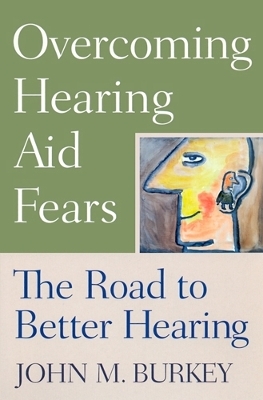
Overcoming Hearing Aid Fears
The Road to Better Hearing
Seiten
2003
Rutgers University Press (Verlag)
978-0-8135-3310-0 (ISBN)
Rutgers University Press (Verlag)
978-0-8135-3310-0 (ISBN)
- Lieferbar (Termin unbekannt)
- Versandkostenfrei
- Auch auf Rechnung
- Artikel merken
There are dozens of misconceptions about hearing aids: ""They make you look old,"" ""They cause ear infections,"" ""They increase hearing loss,"" ""I can't afford one"". This guide aims to dispel the misinformation that can impair quality of life and encourage those with hearing loss to pursue help.
There are dozens of misconceptions about hearing aids:
“They make you look old.”
“They cause ear infections.”
“They increase hearing loss.”
“I can’t afford one.”
This misinformation impairs a person’s quality of life by discouraging them from pursuing help. Technological advances have enabled hearing aids to address a greater range of hearing losses, while making them smaller, better designed, and easier to use than those of the past. More people than ever can benefit from a hearing aid, yet of the nearly thirty million people with a hearing impairment, only about 20 percent choose to use one.
In Overcoming Hearing Aid Fears, audiologist John M. Burkey addresses common fears, concerns, and misconceptions about hearing aids to help readers decide whether these devices will prove useful. Using an informal, anecdotal style informed by years of clinical practice, Burkey provides practical information about hearing aid styles, options, and costs. His expertise and experience in caring for more than 50,000 patients will help people with hearing loss address their personal concerns. The book also helps friends and family understand why a loved one might resist getting a hearing aid, and offers tips on counseling. Audiologists will find this text an important educational tool in advising their own patients.
Approximately 10 percent of Americans (and nearly one-third of people age seventy and older) have some degree of hearing loss that, if left untreated, causes frustration, isolation, and depression. A hearing aid is a simple tool to improve careers, relationships, and self-esteem, and to provide independence and security. Overcoming Hearing Aid Fears can help readers take that first step to a better life.
There are dozens of misconceptions about hearing aids:
“They make you look old.”
“They cause ear infections.”
“They increase hearing loss.”
“I can’t afford one.”
This misinformation impairs a person’s quality of life by discouraging them from pursuing help. Technological advances have enabled hearing aids to address a greater range of hearing losses, while making them smaller, better designed, and easier to use than those of the past. More people than ever can benefit from a hearing aid, yet of the nearly thirty million people with a hearing impairment, only about 20 percent choose to use one.
In Overcoming Hearing Aid Fears, audiologist John M. Burkey addresses common fears, concerns, and misconceptions about hearing aids to help readers decide whether these devices will prove useful. Using an informal, anecdotal style informed by years of clinical practice, Burkey provides practical information about hearing aid styles, options, and costs. His expertise and experience in caring for more than 50,000 patients will help people with hearing loss address their personal concerns. The book also helps friends and family understand why a loved one might resist getting a hearing aid, and offers tips on counseling. Audiologists will find this text an important educational tool in advising their own patients.
Approximately 10 percent of Americans (and nearly one-third of people age seventy and older) have some degree of hearing loss that, if left untreated, causes frustration, isolation, and depression. A hearing aid is a simple tool to improve careers, relationships, and self-esteem, and to provide independence and security. Overcoming Hearing Aid Fears can help readers take that first step to a better life.
JOHN M. BURKEY is the director of audiology and speech at the Lippy Group for Ear, Nose, and Throat in Warren, Ohio. He is coauthor with his colleagues at the Lippy Group of Hearing Better: Understanding Your Hearing and Ear Care Options.
List of Illustrations
Acknowledgments
Introduction
1. Medical Observations on the Normal, Impaired, and Aided Ear
2. Denial and Acceptance of Hearing Loss
3. Appearance and Deeper Concerns
4. Fears and Doubts
5. Benefits for Hearing Aid User
6. Benefits for Friends and Family
7. Hearing Aids 101
8. Cost
9. Rejoining the Hearing World
Glossary
References
Index
| Erscheint lt. Verlag | 31.10.2003 |
|---|---|
| Verlagsort | New Brunswick NJ |
| Sprache | englisch |
| Maße | 140 x 216 mm |
| Gewicht | 283 g |
| Themenwelt | Sachbuch/Ratgeber ► Gesundheit / Leben / Psychologie ► Lebenshilfe / Lebensführung |
| Medizin / Pharmazie ► Medizinische Fachgebiete ► HNO-Heilkunde | |
| ISBN-10 | 0-8135-3310-4 / 0813533104 |
| ISBN-13 | 978-0-8135-3310-0 / 9780813533100 |
| Zustand | Neuware |
| Haben Sie eine Frage zum Produkt? |
Mehr entdecken
aus dem Bereich
aus dem Bereich
die Prämenstruelle Dysphorische Störung als schwerste Form des PMS
Buch | Softcover (2023)
Kohlhammer (Verlag)
CHF 39,95
Ressourcen stärken, psychisches Wohlbefinden steigern
Buch | Softcover (2023)
Kohlhammer (Verlag)
CHF 49,95
das Stresskompetenz-Buch: Stress erkennen, verstehen, bewältigen
Buch | Softcover (2023)
Springer (Verlag)
CHF 27,95


